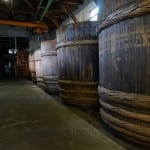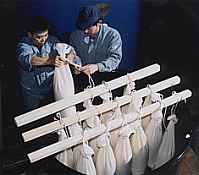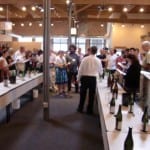 Sake has a long and storied history, going back centuries and centuries. Just how many centuries is a matter of interpretation: exactly when did the rice-based mash look and taste enough like today’s brew to call it sake? The answer likely depends on who is trying to convince whom of what.
Sake has a long and storied history, going back centuries and centuries. Just how many centuries is a matter of interpretation: exactly when did the rice-based mash look and taste enough like today’s brew to call it sake? The answer likely depends on who is trying to convince whom of what.
But most agree that sake brewing goes back some 1700 years, based on archeological finds that show that the locals were deliberately making an alcoholic beverage from rice. It hardly resembled the glorified ambrosia we take for granted today, but if you want to trace the history of sake, that is where it leads.
We also hear from time to time about kami-kuchi sake. This was made by folks chewing rice a bit and spitting it into a vat around which they stood. The enzymes in their saliva converted the starch into sugar, after which yeast in the air took things from there and converted that into alcohol. Appetizing, iddn’t it?
But really: this is cave-man stuff. There was never a commercial product. No one really made proper sake in this way f’gad’s sake. Nor do any of Japan’s written histories or sake-brewing records mention  any such a method. Yet so many writers likes to latch on to it and open stories about sake with references to it. It just makes for good article content fodder, at least the first thousand times you read it; then it just gets old and annoying. But I digress.
any such a method. Yet so many writers likes to latch on to it and open stories about sake with references to it. It just makes for good article content fodder, at least the first thousand times you read it; then it just gets old and annoying. But I digress.
Lots of progress was made in the eleventh to thirteenth centuries in Buddhist temples in and about Nara, and that transitioned into the current method of making sake, which has remarkably remained pretty much the same, at least in terms of principles and objectives. Sure, modern machines save labor and cost. And very cheap sake is indeed made using methods that are far from traditional methods that yield stuff that does remarkably resemble sake.
But most premium sake is made in old, hassle-laden methods that have been around for centuries. Modern machines can help avert labor by moving heavy things around. But the assessments at each stage and the on-the-fly tweaking are performed in traditional painstaking methods.
 Most breweries are owned and run by families (way over 90 percent are family owned operations) that were once aristocratic and can trace their lineage back sometimes tens of generations. As such, many kura today have long, long traceable histories.
Most breweries are owned and run by families (way over 90 percent are family owned operations) that were once aristocratic and can trace their lineage back sometimes tens of generations. As such, many kura today have long, long traceable histories.
In fact, there are still about 300 sake companies in Japan that were founded before 1800, in other words, that many have an over-200 year history!
Here is a list of Japan’s oldest sake breweries and the area in which they are located. Note, the top ten alone are all more than 458 years old!
10. Ueda Shuzo in Nara, brewers of Kicho, founded in 1558
9. Konishi Shuzo in Hyogo, brewers of Shirayuki, founded in 1550
8. Yoshinogawa Shuzo in Niigata, brewers of Yoshinogawa sake, founded in 1548
7. Shusenkurano in Nagano, brewers of Genbu, founded in 1540
6. Tomita Shuzo in Shiga, brewers of Shichiyonyari, founded in 1543
5. Yamaji Shuzo in Shiga, brewers of Kuwazake, founded in 1532
4. Kenbishi Shuzo in Hyogo, brewers of Kenbishi, founded in 1505
3. Hiraizumi Shuzo in Akita, brewers of Hiraizumi, founded in 1487
2. Sudo Honke in Ibaraki, brewers of Sato no Homare, founded before 1141
1. Imanishi Shuzo in Nara, brewers of Mimuro Sugi, estimated to be over 900 years old.
Currently there are less than 1200 brewers that continue to sell sake, Old Kura
although several hundred more have retained their licenses to do so. There were as many as ten thousand at one point in the early twentieth century. While it may be tempting to focus on how many have disappeared, it is amazing to see that such a traditional industry has survived more or less intact, and is now after decades of decline beginning to turn around gradually.
Let us all do our part! Enjoy some sake tonight with a heartfelt “kampai!” for the history of sake and its oldest members.
~~~~~~~~~~~~~~~~~~
 Only about five seats remain open for Sake Professional Course Chicago 2016, March 28~30. Learn more here, and contact me if you are interested in attending.
Only about five seats remain open for Sake Professional Course Chicago 2016, March 28~30. Learn more here, and contact me if you are interested in attending.




